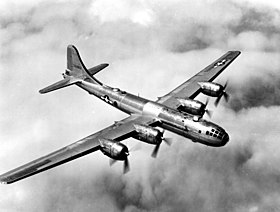
Back قاذفة ثقيلة Arabic Bombarder pesant Catalan Bombardero pesado Spanish بمبافکن سنگین Persian Bombardier lourd French Pesawat pengebom berat ID Bombardiere pesante Italian Sunkusis bombonešis Lithuanian Pesawat pengebom berat Malay Важкий бомбардувальник Ukrainian

Heavy bombers are bomber aircraft capable of delivering the largest payload of air-to-ground weaponry (usually bombs) and longest range (takeoff to landing) of their era. Archetypal heavy bombers have therefore usually been among the largest and most powerful military aircraft at any point in time. In the second half of the 20th century, heavy bombers were largely superseded by strategic bombers, which were often even larger in size, had much longer ranges and were capable of delivering nuclear bombs.
Because of advances in aircraft design and engineering — especially in powerplants and aerodynamics — the size of payloads carried by heavy bombers has increased at rates greater than increases in the size of their airframes. The largest bombers of World War I, the Zeppelin-Staaken Riesenflugzeuge of Germany, could carry a payload of up to 4,400 pounds (2,000 kg) of bombs; by the latter half of World War II, the Avro Lancaster (introduced in 1942) routinely delivered payloads of 14,000 pounds (6,400 kg) (and sometimes up to 22,000 lb (10,000 kg)) and had a range of 2,530 miles (4,070 km), while the B-29 (1944) delivered payloads in excess of 20,000 pounds (9,100 kg) and had a range of 3,250 miles (5,230 km). By the late 1950s, the jet-powered Boeing B-52 Stratofortress, travelling at speeds of up to 650 miles per hour (1,050 km/h) (more than double that of a Lancaster), could deliver a payload of 70,000 pounds (32,000 kg), over a combat radius of 4,480 miles (7,210 km).
During World War II, mass production techniques made available large, long-range heavy bombers in such quantities as to allow strategic bombing campaigns to be developed and employed. This culminated in August 1945, when B-29s of the United States Army Air Forces dropped atomic bombs over Hiroshima and Nagasaki in Japan.
The arrival of nuclear weapons and guided missiles permanently changed the nature of military aviation and strategy. After the 1950s intercontinental ballistic missiles and ballistic missile submarines began to supersede heavy bombers in the strategic nuclear role. Along with the emergence of more accurate precision-guided munitions ("smart bombs") and nuclear-armed missiles, which could be carried and delivered by smaller aircraft, these technological advancements eclipsed the heavy bomber's once-central role in strategic warfare by the late 20th century. Heavy bombers have, nevertheless, been used to deliver conventional weapons in several regional conflicts since World War II (for example, B-52s in the Vietnam War).
Heavy bombers are now operated only by the air forces of the United States, Russia and China. They serve in both strategic and tactical bombing roles.